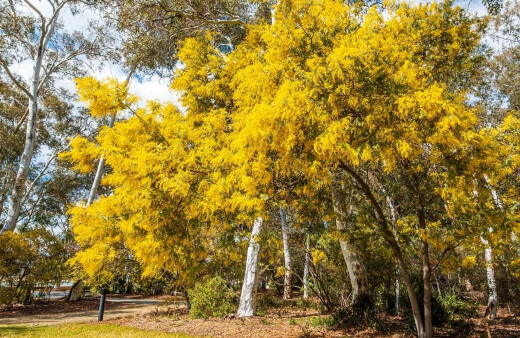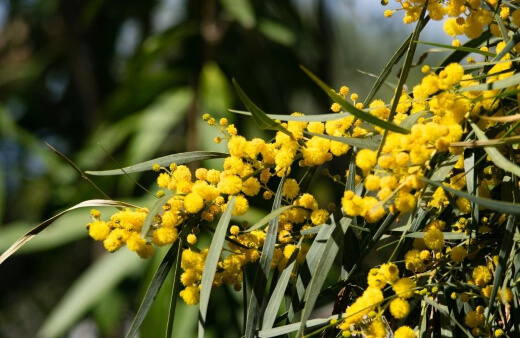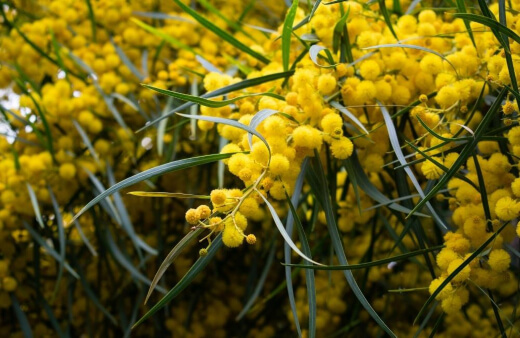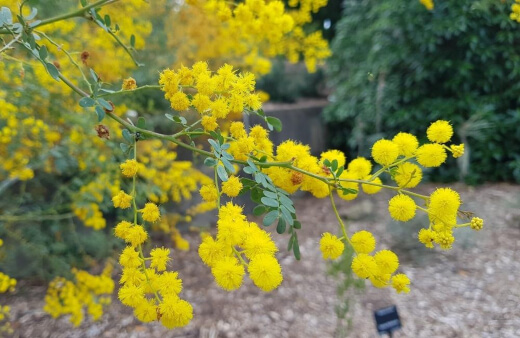Australia’s national flower, the Acacia pycnantha, is more commonly known as the Golden Wattle. This national beauty is a tree of the family Fabaceae, which is native to southeastern Australia.
We’ve got some helpful insights if you’re looking for tips on how to plant, grow and care for these indigenous beauties. Perhaps you just need some trouble-shooting advice on common problems these plants can experience. We’ve got you covered in this golden wattle growing guide.
More...
Meet Australia’s Golden Wattle
She’s tall, growing to a height of up to 8 meters. The golden wattle has flattened leaf stalks instead of real leaves and produces fragrant, golden flowers which arrive in late winter and spring.
The golden wattle features proudly on the Australian coat of arms and Australia celebrates Wattle Day on September 1st.
Uses of the Golden Wattle

This Australian native is grown around the world for the tannin in its bark and trees can be harvested for tannin from seven to ten years of age. The tree has high value as a fuel wood and the scented flowers have been used for perfume making and honey production in humid areas.
In southern Europe, Acacia pycnantha is one of several species grown for the cut-flower business. Something that the wattle species have in common is that they ooze gum when they are stressed. This gum is eaten by indigenous Australians.
It’s even been considered as a possible alternative to gum arabic, which is commonly used in the food industry. Gum arabic is used as an emulsifier and a thickening agent in icing, fillings, chewing gum, and other sweet treats.
Golden wattle is popular as an ornamental plant, but has also been used as a windbreak and to control erosion. These trees are sometimes planted with the taller sugar gum (Eucalyptus cladocalyx) to make a two-layered windbreak.
How to Grow Golden Wattle

Acacia pycnantha needs the following for healthy and optimal growth:
- Clay, loamy or sandy soil
- Soil needs to be well-drained
- Soil pH that is acid or neutral
- Full sunlight
In milder climates, this can be planted at any time of the year. Regions with hot dry summers should wait until autumn or winter to give them time to settle in before the heat of summer.
Golden wattles are very hardy, and they’re smart too. They often germinate from seed present in the soil’s seed bank and grow up quickly in areas that have become open after a fire for example.
Acacia pycnantha can quickly germinate in large numbers and creates a green cover that will protect other plants and animals. Quite a helpful plant to have in the garden!
The fast growing golden wattle is ideally bought as a young plant or grown from seed. By planting when they are young, the tree will develop a good root system immediately in the soil.
If you grow it in a pot until it’s older, it might struggle to develop a good root system once it’s planted.
Propagation of Golden Wattle from seed

Propagation is quite easy if you follow normal seed raising methods. You do however need to do a pre-treatment by soaking the seed in boiling water or by scarification.
Propagation from a cutting can be successful but this method isn’t really used.
Collecting Golden Wattle seed
The pods with ripe seed will be on the plant about three to six months after flowering. The best way to know that the seed is ripe? When the seedpods dry up and turn brown.
The seeds will of course be ripe when the pods split open, but many seeds will have fallen to the ground already. You need to keep an eye on the pods and choose a time just before the pods will crack open.
Once you’ve collected them, place the seed pods in a dry sunny spot and wait for them to split open and release their seed.
Preparing the Acacia pycnantha seed
Seeds have a very tough outer seed coat that does not let water through. The seed needs this armour, considering it needs to stay dormant underground for months and years before germinating successfully under the right conditions.
This is why if you plan to grow from seed at home, you need to treat the seed with a pre-germination seed treatment method. After you’ve removed the seed from the pods, apply a pre-germination seed treatment to get the seed to germinate.
The most often used method is the hot water method. Here is an overview of the process:
- Pour hot water over the seeds and let it stand overnight
- Place the seed in damp paper towels in a closed container in a dark place until it germinates
- Sow the germinated seed with 1/4 coco peat and 3/4 sand mix at 0.5 cm depth
Caring for Golden Wattle

You need to water the seedling regularly and keep it in a sheltered spot with good lighting, but no direct sun. You can grow the seedling until it has a good root system that will allow it to survive in the ground. Gradually start placing it in more sun as it gets stronger.
Fertilising and Maintenance of Golden Wattle
This Australian native doesn’t like too much phosphorus and usually has low nutrient requirements. Established plants can be fertilised in spring and autumn with a layer of compost or a certified organic native fertiliser.
Not sure which fertiliser to go for? Our complete Australian garden fertiliser users guide will help you make the best choice for your plants.
The tree doesn’t usually need pruning but some people believe it extends their life. If you are going to give it a snip, be sure to use a reliable tree pruner or pole saw and prune after flowering finishes.
Common Golden Wattle Pests and Diseases

If the climate is right, you should have minimal problems with your plant. If there are going to be any challenges, these are the things to look out for:
- Borers – these pests burrow into the trunk and main branches of the tree which can cause it to die. Look out for oozing sap and any kind of sawdust material which are signs the tree is under attack.
These grubs are virtually impossible to kill as insecticides can’t reach them. Sometimes it is possible to prune off any affected branches. These pests usually go for stressed or ageing trees.
You might get rid of them temporarily but essentially you need to de-stress the tree as well. - Bag-shelter moths – these caterpillars build what looks like a bag of leaves and twigs where they hide out during the day and then feed on leaves at night. They have monster appetites and can strip a plant in no time.
If possible, you can remove the ‘bags’ but be sure to wear gloves. The caterpillars have long brown hairs that can cause a painful rash. If you can’t remove the bags, you can spray the tree with neem oil to keep those pesky caterpillars under control.
If you need to stock up on gloves and other gardening attire, we’ve listed and reviewed our favourite garden attires to make your shopping that much easier. - Galls – these are small bumps or growths sometimes found on the foliage or stems. They are usually caused by various insects. If your golden wattle is healthy then you have nothing to worry about – you can just prune them off.
If the tree has a lot of them then it’s generally a sign the plant is struggling. There is a fungal disease called gall rust which causes larger galls to develop (up to 15cm across). If this happens, prune them out to minimise further spread. - Spittle bugs – these small insects suck the sap of the tree. They cover themselves with white froth, which explains their name. You don’t really need to spray them as they don’t cause any damage. The white froth or spittle can look ugly so just rinse it off if it gets unsightly.
Golden Wattle Frequently Asked Questions

Does the golden wattle live for many years?
The golden wattle has quite a short lifespan of 15 to 30 years.
Is it true that the golden wattle is actually considered a weed in some parts of the world?
The Acacia pycnantha is considered a weed in South Africa, Tanzania, Italy, Portugal, Sardinia, India, Indonesia and New Zealand, as it’s in competition with the native vegetation.
How does Acacia pycnantha harness nitrogen from the atmosphere?
The tree hosts bacteria called rhizobia that form root nodules, where they make nitrogen available in organic form. This helps the plant to grow in poor soils.
Does the golden wattle fertilise itself?
Acacia pycnantha can’t fertilise itself and needs cross-pollination between plants.
Can the golden wattle survive a drought?
The tree does become drought resistant once it’s established.
Is the golden wattle related to the bean family?
Yes, the tree belongs to the plant genus Acacia, which is a member of the legume, pea, or bean family also called Fabaceae.

Start Growing Golden Wattle with Pride
Acacia pycnantha is a national treasure for many reasons. The golden wattle is hardy yet beautiful, fast growing and fragrant, and represents Australia with pride.
Although it’s considered a weed in some parts of the world, we’re won over by the ever lovely yellow blooms. We’re happy to give this southeastern Australia native our thumbs up!
Published on February 22, 2022 by Nathan Schwartz
Last Updated on February 12, 2024




